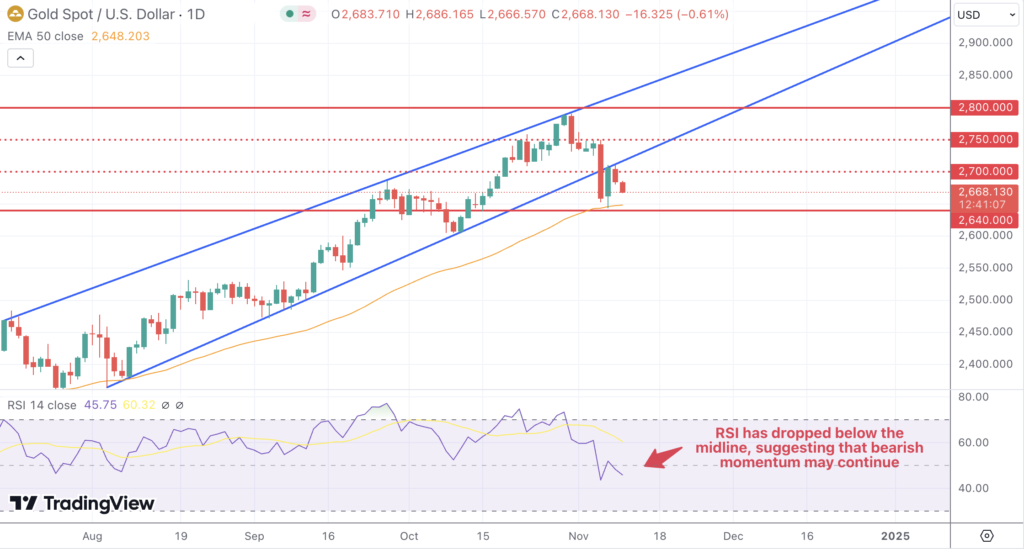Key Takeaways
- Gold is facing resistance around $2,700-$2,720, with critical support levels at $2,650 and $2,595.
- The daily RSI suggests a bearish tilt, with the potential for further corrections.
- S. inflation data will be pivotal, as CPI and PPI results could shape Fed policy expectations and influence the dollar’s strength.
- Investor sentiment remains split between safe-haven demand for gold and the appeal of higher Treasury yields.
Market Dynamics and Recent Performance
Gold (XAU/USD) has experienced a period of consolidation around $2,672 after rebounding from lower support levels. The recent U.S. presidential election and fluctuating Treasury yields have heightened volatility in the market, affecting safe-haven assets like gold. While demand for gold has been relatively stable, the strong U.S. dollar, supported by rising yields and a recent Federal Reserve rate cut, has limited further upside. Investors are now looking closely at upcoming U.S. inflation data to gauge the Fed’s potential path forward, which will significantly influence gold prices in the near term.
Technical and Fundamental Influences
Technically, gold has encountered resistance near the blue trend line on the daily chart, failing to break above the $2,700-$2,720 range. The recent correction from this resistance saw gold finding support at the 50-day simple moving average (EMA), indicating a solid floor near $2,650. However, the Relative Strength Index (RSI) on the daily chart has dropped below the midline, suggesting that bearish momentum may continue to pressure gold in the short term. Key support levels to watch are around $2,650, with a more robust floor at $2,595, which aligns with the support of an ascending broadening wedge pattern.

Fundamentally, the U.S. dollar’s strength has been a headwind for gold, particularly as Treasury yields climbed to recent highs. Although the Federal Reserve’s recent rate cut would typically favor gold by reducing the opportunity cost of holding non-yielding assets, market sentiment has turned cautious. Investors are balancing gold’s appeal as a safe haven with attractive yields on U.S. bonds. The upcoming release of the Consumer Price Index (CPI) and Producer Price Index (PPI) will be critical for assessing inflation trends, which could alter Fed policy expectations. Elevated inflation could support gold prices by reinforcing the metal’s role as a hedge, especially if the Fed hints at a slower pace of rate hikes in response.
Looking Forward
The coming week’s focus will be on U.S. inflation data, with the CPI and PPI set to provide a clearer picture of inflationary pressures. If these reports exceed expectations, the Fed might signal a pause on rate cuts, which could pressure gold further, especially if the U.S. dollar remains strong. Conversely, weaker-than-expected inflation figures could lead to renewed optimism for gold as a hedge, especially if bond yields stabilize or decline. Additional market-moving factors include retail sales data, which will offer further insights into consumer resilience amid economic uncertainty.

